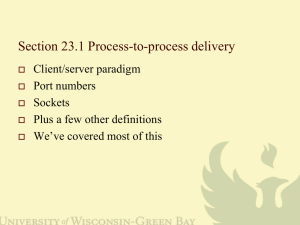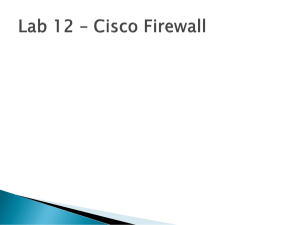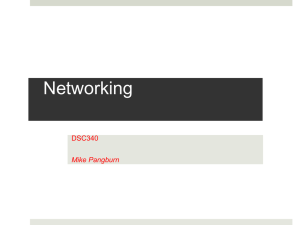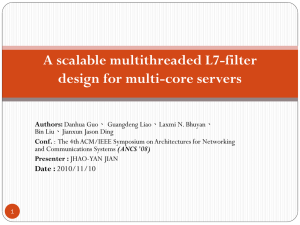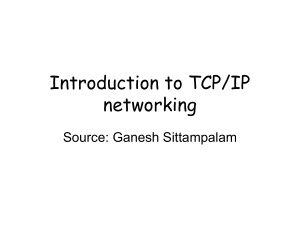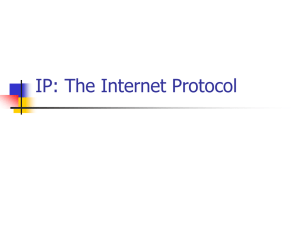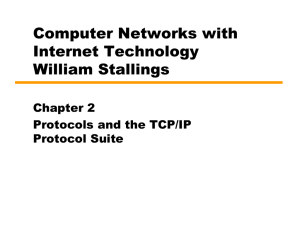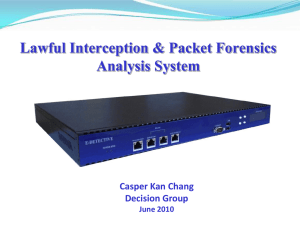Network Architecture Models - Eastern Illinois University
advertisement
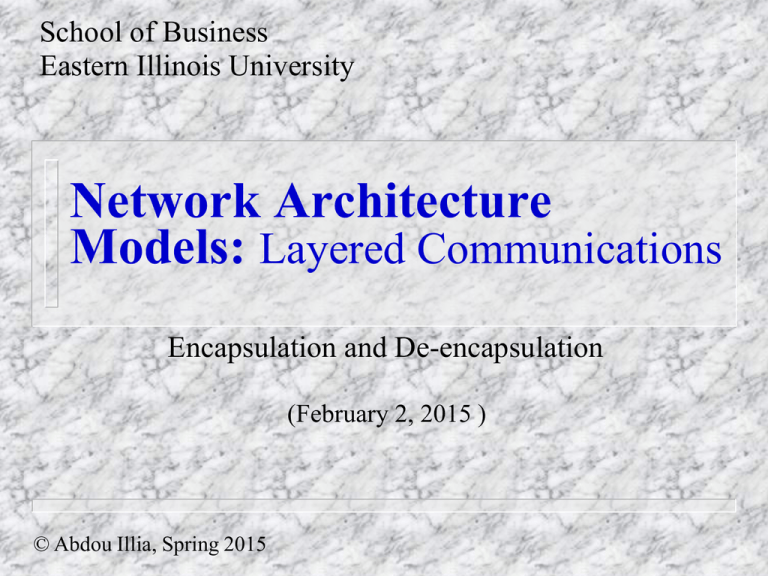
School of Business Eastern Illinois University Network Architecture Models: Layered Communications Encapsulation and De-encapsulation (February 2, 2015 ) © Abdou Illia, Spring 2015 Learning objective Understand the principles of layered communications 2 Hybrid TCP/IP-OSI Model Layers Sample protocols for Web access Application HTTP Transport TCP Internet IP Data Link Ethernet, PPP Physical Ethernet, Modem standards, Telephone standards 3 4 Layered Communications Application programs on different computers cannot communicate directly – – There is no direct connection between them! They need to use an indirect communication system Browser HTTP Request Web App Trans Trans Int Int DL DL Phy User PC Phy Webserver Layer Cooperation on the User PC Application layer passes HTTP-request to Transport layer Application HTTP Request Transport Internet Data Link User PC Physical 5 Layer Cooperation on the User PC Transport layer creates a TCP segment – – 6 HTTP request is put in the data field A TCP header is added So, Transport layer “encapsulates” HTTP request within a TCP segment TCP Segment HTTP Request TCP-H Data Field TCP Header 7 Encapsulation Encapsulation is: – Embedding a received message in the data field of a new message Example: TCP encapsulates HTTP request in the data field of a new massage called TCP Segment TCP Segment HTTP Request TCP-H Data Field TCP Header Layer Cooperation on the User PC Transport layer passes the TCP segment down to the Internet layer Application Transport TCP segment Internet Data Link User PC Physical 8 9 Layer Cooperation on the User PC Internet Layer encapsulates TCP Segment within an IP packet – An IP packet to deliver a TCP segment has a TCP segment in its data field IP Packet TCP segment IP-H Data Field IP Header Layer Cooperation on the User PC The Internet layer passes the IP packet to the Data Link layer – Internet layer messages are called packets Application Transport Internet IP packet Data Link User PC Physical 10 Layer Cooperation on the User PC Data Link Layer encapsulates IP Packet within a PPP Frame – Data Link layer messages are called frames – PPP frame has IP packet in data field – PPP frame has a PPP Trailer and a PPP Header PPP Frame Encapsulating an IP Packet PPP-T IP packet PPP-H 11 Layer Cooperation on the User PC 12 The Data Link layer passes the PPP frame to the Physical layer, which delivers it to the Physical layer on the first router, one bit at a time (no message at the Physical layer) Application Transport Internet Data Link User PC PPP frame Physical (10110 …) To first router Layer Cooperation on the User PC 13 Recap: Adding Headers and Trailers: Application HTTP req. Transport HTTP req. TCP-H Internet HTTP req. TCP-H IP-H HTTP req. TCP-H IP-H PPP-H Data Link User PC PPP-T Physical TCP segment Source Port # and Destination Port #: – – Bit 0 Contain reference # of application programs at both ends Used (together with IP address) to identify the application program Sequence Number: – – 14 Indicates position of this segment within sequence of segments Used to perform error recovery (e.g. loss of continuity) TCP message has a Flags Field (three of which widely used) – – – SYN bit set to 1 to request a connection ACK bit set to 1 to acknowledge a received TCP segment FIN bit set to 1 to inform of a connection closure Source Port # (16) Bit 31 Destination Port # (16) Sequence Number (32 bits) TCP Header Acknowledgement Number (32 bits) Hdr Len Reserved (6) (4) Flags (6) TCP Checksum (16) Window Size (16) Urgent Pointer (16) Options (if any) Data Field PAD TCP Segment 15 Transmission Control Protocol. Src Port http (80). Dst Port 1958). Seq: 3043958669. Ack: 937013559. Len:0 Source port: http (80) Destination port: 1958 (1958) Sequence number: 3043958669 Acknowledgment number: 937013559 header length: 24 bytes Ө Flags_0xx0012 (SYN, ACK) 0………. = Congestion window reduced (CWR): not set ..0…….. = ECN-Echo: not set …0……..= Urgent: Not set ….1…….= Acknowledgment: Set ……0…..= Push: Not set …….0….= Reset: Not set ……..1…= Syn: Set ………0..= Fin: Not set Window size: 5840 Checksum: 0x206a (correct) Ө Options: (4 bytes Maximum segment size: 1460 byte 16 UDP Segment 0 16 31 Source Port Destination Port Length Checksum Data Data Dean (2004:161) IP Packet Version IHL 17 Differentiated services Total length Flags Fragment offset Identification Time to live Protocol Header length Reserved U R G A C K P S H Header checksum R S T S Y N F I N Sliding-window size Source IP address Destination IP address Options Padding Data Contains: – – – IP version used Source IP address Destination IP address, etc. Layer Cooperation on the Webserver Situation reverse to Situation on User PC (Deencapsulation) Application Transport Internet Data Link User PC Physical Webserver 18 Layer Cooperation on the Webserver 19 Data Link layer processes the DL-Frame’s header and trailer to deencapsulate the IP packet Data Link layer passes the IP packet to the Internet layer Application Transport IP-Packet DL-Frame containing IP packet in data field Final Router Physical Internet Data Link Webserver Layer Cooperation on the Webserver 20 Successively pass up layer messages – Other layers pass successive data fields (containing nextlower layer messages) up to the next-higher layer HTTP request HTTP req. TCP segment HTTP req. TCP-H IP Packet HTTP req. TCP-H IP-H PPP-T HTTP req. TCP-H IP-H PPP-H Data Link Physical Webserver Final Router Application Transport Internet Hybrid TCP/IP and Windows Layering Hybrid TCP/IP-OSI Layering Microsoft Windows Layering Application Clients and Services Transport Protocols Internet (TCP/IP, IPX/SPX, NetBEUI, etc.) Data Link Adapters Physical (Dial-up adapters, Network Interface Card, etc.) 21 Windows Architecture implementation F ig u re 2Dialog .1 4 : N e tw o rk D iain lo gWindows B o x in W in d o w s 9 8 Network box P ro p e rtie s B u tto n 22 Summary Questions 1. (a) What is layered communication? (b) Why is it necessary ? (c) What is encapsulation? (d) What happens as soon as a layer on the source computer creates a message? 2. At which layer IP addresses of the sending and the receiving computers are added to the message? 3. At which layer MAC addresses of the sending and the receiving computers could added to the message? 4. At which layer a Trailer is usually added. 5. Compare Hybrid TCP/IP layering and Windows layering. 23 Summary Questions (cont.) 24 Given the TCP/IP communications diagram illustrated below, label each layer with its appropriate name Dear John, Today we made good progress on the text. I think it will be a great success. Dave Dear John, Today we made good progress on the text. I Destination address 10.0.0.2 Destination address 10.0.0.2 Destination address 10.0.0.2 Destination address 10.0.0.2 Dest. MAC addr. 00A0CC5F745D Dest. MAC addr. 00A0CC5F745D Dest. MAC addr. 00A0CC5F745D Dest. MAC addr. 00A0CC5F745D Source address 10.0.0.1 Source address 10.0.0.1 Source address 10.0.0.1 Source address 10.0.0.1 think it will be a great success Dave Dave think it will be a great success good progress on the text. I Dear John, Today we made Source MAC addr. Destination address 00A0CC5F745D 10.0.0.2 Source MAC addr. Destination address 00A0CC5F745D 10.0.0.2 Source MAC addr. Destination address 00A0CC5F745D 10.0.0.2 Source MAC addr. Destination address 00A0CC5F745D 10.0.0.2 …100011101000011001110011 Source address 10.0.0.1 Source address 10.0.0.1 Source address 10.0.0.1 Source address 10.0.0.1 Dave think it will be a great success good progress on the text. I Dear John, Today we made Additional slides 26 The First Router First router receives an IP packet (encapsulated in a frame) in one port (interface) Must make a router forwarding decision: select the port to use to send it back out B B? D? Router A D Packet C? C Layer Cooperation on the First Router So far, we have only looked at User PC & Webserver – 27 But deencapsulation and encapsulation also occur on EACH router Frame arrives at a port on the first router – Port’s Data Link layer receives the PPP frame containing an IP packet Internet PPP Frame Data Link Data Link First Router Layer Cooperation on the First Router Incoming Data Link on the Router – – Deencapsulates the IP packet from the PPP frame Passes the IP packet to the router’ Internet layer First Router Internet IP Packet Data Link Data Link Incoming Port on First Router 28 Layer Cooperation on the First Router 29 Routers only have Physical, Data Link, and Internet layer – – So Internet layer is the highest layer on a router for router forwarding Internet layer decides where to send the packet next: another router or the destination Webserver Internet Data Link Data Link First Router Layer Cooperation on the First Router 30 Internet layer passes IP packet to Data Link layer on the selected output port that will carry the IP packet to the next router or the destination Webserver First Router Internet Data Link IP Packet Data Link Selected Output Port on First Router Layer Cooperation on the First Router 31 The Data Link and Physical layer on the selected port sends the frame encapsulating the IP packet onto the next router (or destination Webserver) Internet Internet Data Link Data Link Frame Selected Output Port On First Router Physical Layer Input Port On Next Router (or Destination Webserver)
